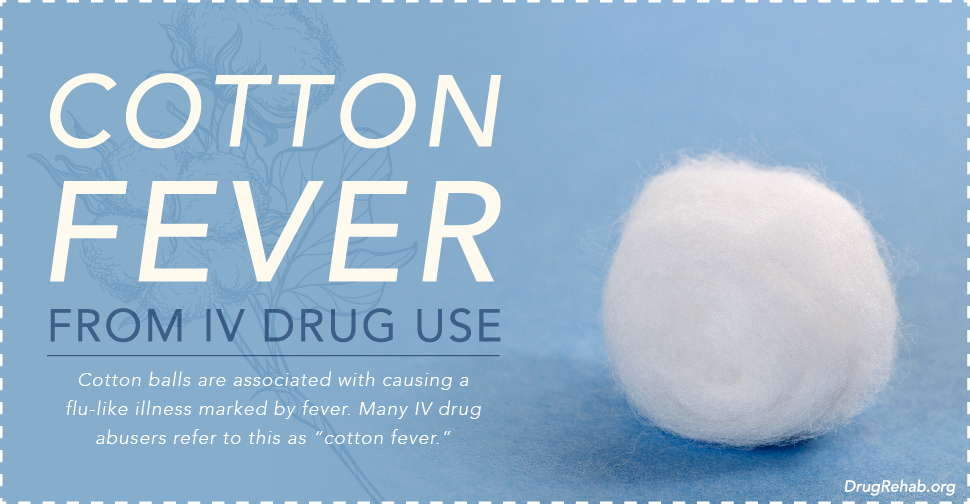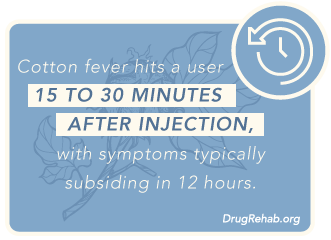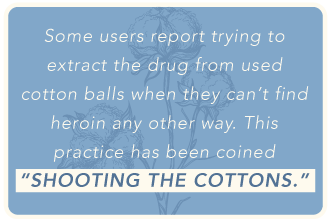
When an intravenous (IV) injection drug user prepares their drug of choice, they may have to filter the substance before they fill the syringe with it. To do this, many people use makeshift filters made from cigarette filters or cotton balls. The latter material is associated with causing a flu-like illness marked by fever. Many IV drug abusers refer to this as “cotton fever.” Cotton fever hits a user 15 to 30 minutes after injection, with symptoms typically subsiding in 12 hours.
What Is Intravenous Drug Use?
People inject drugs a number of ways. The most common way is by injecting the substance directly into the vein. Many users prefer IV drug injection because it causes the most rapid effect. To do this, a person dilutes or liquefies the drug, often by heating it. After the drug becomes liquid, it’s then loaded into the syringe. Certain drugs must be filtered before this step can occur, due to the number of impurities in the substance. This is a common practice with heroin.
 Again, cotton balls are commonly used for this purpose since they are so cheap and readily available. Once a drug is in liquid form, a person draws the substance through the filter and into the syringe. The forearm is a primary injection site for many users, however, other locations may also be used to “shoot up” or inject the drug.
Again, cotton balls are commonly used for this purpose since they are so cheap and readily available. Once a drug is in liquid form, a person draws the substance through the filter and into the syringe. The forearm is a primary injection site for many users, however, other locations may also be used to “shoot up” or inject the drug.
What Is Cotton Fever?
Heroin is most closely associated with cotton fever. But a Journal of General Internal Medicine (JGIM) article notes that hydromophone or a combination of pentazocine and methylphenidate have also been linked to the condition. The article continues, reporting that “injection drug users estimate the incidence of cotton fever to about 5 % per year of use.”
Unlike many of the other medical risks associated with IV drug abuse, cotton fever is considered to be a benign syndrome. This means that the condition doesn’t become severe or life-threatening over time, even without treatment (though certain medications can be used to alleviate symptoms). Cotton fever also resolves on its own, with symptoms typically dissipating in six to twelve hours. More severe cases may last one to two days. But this does not mean that you shouldn’t seek treatment.
Intravenous drug use is associated with a host of illnesses and disease. Many of these, like cellulitis, endocarditis, and even pneumonia can cause symptoms which are similar to cotton fever. This similarity can cause two problems.
Cotton fever can be overlooked or misdiagnosed, leading to unnecessary and prolonged medical care. The JGIM article comments on this, noting that “The importance of recognizing cotton fever is paramount, as early suspicion may reduce expensive secondary evaluations and the length of hospitalization.”

Secondly, other illnesses could be misdiagnosed as cotton fever. While this is fairly rare in a medical setting, it’s important that other more serious conditions are ruled out by with appropriate testing. Also, some users may be quick to think their symptoms are only cotton fever and fail to seek medical help. Should these symptoms be tied to a different condition, a person could greatly be jeopardizing their health or even life. Without the proper treatment, certain other IV-related conditions can become quite dangerous or even deadly.
What Are The Symptoms Of Cotton Fever?
Symptoms of cotton fever hit quickly and often occur as soon as 15 or 20 minutes after using the drug. As we noted, cotton fever resembles the flu, with symptoms including:
- Abdominal pain
- Abnormally fast heartbeat (tachycardia)
- Chills
- Elevated white blood cell count (leukocytosis)
- Fever
- Headache
- Mild distress
- Muscle aches and pain
- Nausea
- Shortness of breath
- Vomiting
According to the article “Cotton Fever: A Condition Self-Diagnosed by IV Drug Users” a patient may meet systemic inflammatory response syndrome criteria, a set of symptoms which include many of the above. These criteria could point to an underlying infection. For this reason, sepsis or other infections should be ruled out.
What Causes Cotton Fever?
While the IV drug user community has long been familiar with cotton fever, medical research is still somewhat sparse on the subject. Researchers and medical professionals are still not entirely sure what causes it.
Any contact with cotton as a drug filter is suspected, but another practice is thought to increase the risk. When a person becomes addicted to a drug, they experience an intense need to use it. Because of this, they will often go to great lengths to find the drug and will even do so in ways which could become harmful to their health. Some users report trying to extract the drug from used cotton balls when they can’t find heroin any other way. This practice has been coined “shooting the cottons.” After sitting out for some time, these cotton balls could harbor bacteria or other pathogens.
Beyond this, the aforementioned article does propose three theories which discuss possible explanations of why this cotton fever occurs:
 Immunologic theory: Users have antibodies for the cotton which cause a reaction after injection
Immunologic theory: Users have antibodies for the cotton which cause a reaction after injection
Pharmacologic theory: When the drug enters a person’s bloodstream it contains substances from the cotton which cause fever (pyrogenic substances). These substances are water-soluble, so the liquid form of the drug has a tendency to dissolve them.
Endotoxin theory: Certain Gram-negative bacteria live on the cotton plant. These bacteria produce an endotoxin which is carried through to drug and subsequently to the patient, causing fever. Blood cultures do support this theory, as certain bacteria have been found in the used cotton which was linked to the illness.
The latter theory appears to be recognized as the most probable, and the JGIM article asserts that “no evidence has been found to support the immunologic or pharmacologic theory.” Even though cotton fever will resolve on its own, it’s still important you seek medical help to confirm that this is the correct diagnosis.
How Is Cotton Fever Treated?
When a patient is first admitted or examined for cotton fever, blood tests and cultures should be done. While waiting for these results, broad-spectrum antibiotics may be administered in case the symptoms are caused by another more serious condition. Depending on the severity of the person’s substance use disorder, they may require withdrawal management during this time.
Certain over-the-counter medications may be administered to control the fever, muscle aches, nausea, and/or vomiting. If a person has become severely dehydrated they may also receive IV fluids.
Like any other illness or disease caused by IV drug use, cotton fever can be avoided. Good drug addiction treatment can help a person achieve sobriety and learn how to live a fulfilling drug-free life.
Live A Healthier Drug-Free Life
Heroin and other drugs which are injected are highly addictive. These addictions can be very hard to beat on your own. Fortunately, you don’t have to do this alone. DrugRehab.org’s compassionate staff can help you to set treatment goals and begin building a plan to obtain them. We have access to phenomenal treatment programs all across the nation. Contact us now for help.
For More Information Related to “Cotton Fever From IV Drug Use” Be Sure To Check Out These Additional Resources From DrugRehab.org:
- Learn How People Use Heroin
- Consequences Of Injecting OxyContin (Oxycodone)
- Signs And Symptoms Of Heroin Use
- Snorting, Smoking, or Injecting Drugs: Which Gets You Addicted
- Using Naltrexone To Treat Opioid Addiction
- The Dangers of Using Heroin with Crack Cocaine


